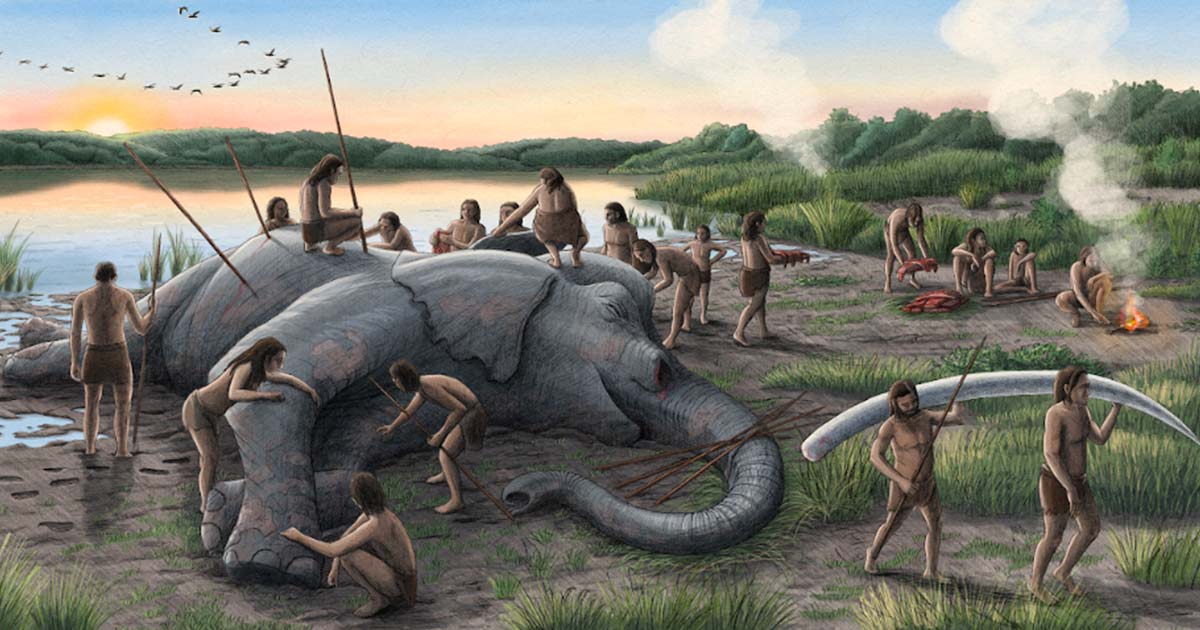Neanderthals Hunted Elephants Twice the Weight of Modern Ones
Evidence has emerged from Germany dated to 125,000 years ago showing Neanderthals hunted elephants twice the size of contemporaneous ones. Building on that information, which provides new insight into the organization of Neanderthal society and sophistication of their hunting techniques, scientists have found that these elephants (roughly 13 tons each) weighed twice the size of mammoths who were eventually hunted into extinction by Homo sapiens!
Hunters of Large Animals: Adept Neanderthals
Neanderthals displayed a remarkable ability to hunt some of the largest land animals of their era, surpassing the size of African elephants, underscoring an unprecedented level of organization and courage among our closest relatives. This also suggests a potential profound influence on Neanderthal society in Europe during interglacial periods between ice ages, according to the new study published in the journal Proceedings of the National Academy of Sciences (PNAS).
Earlier this year, Professor Sabine Gaudzinski-Windheuser and her team at the MONREPOS Archaeological Research Center identified cut marks on bones of straight-tusked elephants ( Palaeoloxodon antiquus) at the Neumark-Nord 1 site in Germany, dating back approximately 125,000 years. While initial observations raised the possibility of scavenging, the abundance of treated bones at the site led the researchers to assert that these elephants were likely hunted.

The locations Neanderthal mammoth hunt of Neumark-Nord, Gröbern, Taubach, and other sites of the northern European plain are indicated in relation to the maximum extents of the Saalian and Weichselian glaciers. (Sabine Gaudzinski-Windheuser/Lutz Kindler/PNAS)
This discovery prompted further investigation into whether Neumark-Nord was unique in this regard or if the hunting of giant elephants was a more widespread practice. The researchers, now examining Palaeoloxodon bones from Gröbern and Taubach in eastern Germany, found a commonality among the three sets of bones, all originating around 125,000 years ago during the last interglacial period, characterized by a climate similar to the present day.
Despite limited samples, such as only one elephant carcass available from Gröbern and 17 bones displaying cut marks from Taubach, the striking similarities across these sites provide compelling evidence of Neanderthals' consistent engagement in giant elephant hunting during this specific historical period.
- Giant Elephant Hunt Reveals Emerging Neanderthal Society
- Neanderthals cleared of herding mammoth over cliff edge

Pelvis of Gröbern elephant remains during inspection for cut marks. (Lutz Kindler/PNAS)
“We identified in both assemblages similar butchering patterns as at Neumark-Nord, demonstrating that extended elephant exploitation was a widespread Neanderthal practice during the (early part of the) Last Interglacial,” they write in the study.
Prime Rib: Targeting Adult Elephants, Calories for the Community
A considerable proportion of individuals within the fossil assemblages were identified as adults, indicating a preference for targeting prime-aged individuals. The authors highlight the significance of processing entire adult straight-tusked elephants, some weighing up to 13 metric tons, as this could yield over 2,500 portions of daily calories.

Sabine Gaudzinski-Windheuser, the author of the study and standing at a height of 160 centimeters (5 ft 2 in), poses beside a life-sized reconstruction of an adult male straight-tusked elephant at the Landesmuseum für Vorgeschichte in Halle, Germany. (Lutz Kindler/PNAS)
These findings imply that Neanderthals potentially had the capability to store substantial amounts of meat and fat, suggesting scenarios where they might have temporarily congregated in larger groups than previously acknowledged. This observation raises the possibility of a combination of factors contributing to Neanderthals' ability to acquire, process, and store significant quantities of resources, according to a press release.
Tooth marks discovered at Taubach indicate the presence of these large carnivores, though their rarity suggests that Neanderthals effectively fended off such competitors for an extended period. While Gröbern and Taubach alone might suggest fortuitous encounters with recently deceased elephants, when considered alongside Neumark-Nord, it becomes more plausible that hunting was a characteristic activity among the region's Neanderthals during this warmer era.

Cut marks on P. antiquus remains from Taubach. (Sabine Gaudzinski-Windheuser/Lutz Kindler/PNAS
Utilization and Storage Challenges
If the hunting of elephants wasn't merely an extreme sport for Neanderthals, undertaken without concern for maximizing benefits, it raises the question of how these large beasts were utilized. The research team conducted calculations, revealing that a single Palaeoloxodon individual could provide enough meat to satisfy a Neanderthal's daily calorie needs a staggering 2,500 times over, even if not exceptionally large, reports IIFL Science.
However, the challenge arose in preserving the meat, given the rapid spoilage, even in winter. The authors posit that Neanderthals might have possessed preservation techniques currently unknown to us, swiftly implementing them, or alternatively, they could have congregated in large numbers to consume the abundant resources. This proposition has the potential to reshape our understanding of Neanderthal society in Germany.
- First Humans in New England May Have Met and Hunted Woolly Mammoths
- Mammoth DNA Breaks Record for World’s Oldest Sequence
The paper suggests that the truth likely lies in a combination of these possibilities. Logistical constraints would have made it impractical for a small group to transport substantial amounts of meat. If preservation was involved, the Neanderthals would have needed to stay in proximity for an extended period to fully exploit the resources, implying a settled lifestyle rather than constant nomadism.
Top image: Artist's reconstruction of a group of Neanderthals butchering a straight-tusked elephant (Palaeoloxodon antiquus). (It is unknown whether Neanderthals wore any type of clothing, so the depiction reflects artistic license). Source: Alex Boersma/PNAS
By Sahir Pandey
References
Gaudzinski-Windheuser, S., et al. 2023. Widespread evidence for elephant exploitation by Last Interglacial Neanderthals on the North European plain. Proceedings of the National Academy of Sciences. Available at: 10.1073/pnas.2309427120 .
Luntz, S. 2023. Elephants Twice The Weight Of Mammoths Were Hunted By Neanderthals 125,000 Years Ago. Available at: https://www.iflscience.com/elephants-twice-the-weight-of-mammoths-were-hunted-by-neanderthals-125000-years-ago-71833.


















Comments
"twice the size of mammoths who were eventually hunted into extinction by Homo sapiens!"
That plus Clovis first equals Dead Horse!
Sargelatch51T